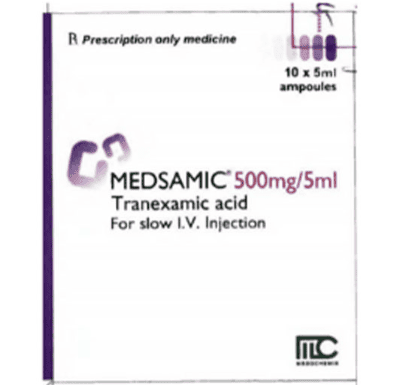This is an automatically translated article.
Flamaz is commonly used as a hemostatic. Flamaz should be used with caution because of some side effects and in special populations.
1. What is Flamaz?
Flamaz is a prescription drug, containing tranexamic acid, which inhibits the activation of plasminogen to plasmin, prevents the creation of plasmin, thereby inhibiting fibrinolysis.Flamaz is made in the form of hard capsules. Flamaz is a product of Flamingo Pharm., Flamaz circulated in Vietnam with the registration number VN-17433-13.
Flamaz administered orally reached the highest concentration of 6.0mcg/ml (with a dose of Flamaz 500mg) and the half-life of the drug was 3.3 hours (Flamaz 500mg). Approximately 30-52% of Flamaz is excreted in the urine 24 hours after oral administration.
2. Effects of the drug Flamaz
Anti-plasmin effect: tranexamic acid will bind to lysine binding site - the site where plasmin and plasminogen have affinity for fibrin, so that tranexamic acid inhibits the binding of plasmin, plasminogen to fibrin and strongly inhibits fibrinolysis destroyed by plasmin. Hemostatic effect: Plasmin too high leads to inhibition of platelet aggregation, the breakdown of coagulation agents... even a slight increase causes fibrin degradation to occur before. Tranexamic acid eliminates the breakdown of fibrin and helps to stop bleeding. Anti-inflammatory, anti-allergic effects: Tranexamic acid inhibits the production of kinins as well as other active peptides - substances that increase vascular permeability, cause inflammation, or allergies. Therefore, tranexamic acid has anti-inflammatory and anti-allergic effects.
3. Indications for the use of Flamaz
Flamaz is used to treat the following pathologies:
Abnormal bleeding during and after surgery. Gynecological bleeding. The business. Bleeding in the lungs, hemolysis due to pulmonary tuberculosis. Nosebleed . Renal bleeding. Urinary and genital bleeding. Bleeding in pathology of the prostate gland.
4. Dosage, how to use Flamaz
Flamaz is used orally, with a daily dose of 250mg to 4000mg, divided into 3-4 times / day.
Flamaz dose for adults:
Usual dose: Take 500mg/time x 2-3 times/day. Hematuria: Take 1000mg/time x 2-3 times/day, drink until there are no more symptoms of hematuria. Severe nosebleed: Take 1000mg/time x 3 times/day, use within 4-10 days. Menorrhagia: Take 1000mg/time x 2-3 times/day, use for 3-4 days. Cervical ablation procedure: Take 1000mg/time x 3 times/day, within 12-14 days after surgery. Do not change the dose of Flamaz on your own without consulting your doctor.
5. Contraindications Flamaz
Flamaz is contraindicated in the following cases:
Hypersensitivity to tranexamic acid. History of thromboembolic disease: Patients with thrombotic disease such as myocardial infarction, cerebral thrombosis, thrombophlebitis or patients with a predisposition to thrombosis. Patients undergoing surgery involving the central nervous system or with bleeding in the central nervous system, subarachnoid hemorrhage or other bleeding in the brain. The patient is being treated with coagulation therapy. Severe kidney failure.
6. Flamaz side effects
Common side effects of Flamaz include:
Dizziness. Symptoms of digestive disorders: Diarrhea, nausea, vomiting, loss of appetite, heartburn. Some other side effects may be encountered in users of Flamaz but are less common:
Hypersensitivity: Manifested by skin symptoms such as itching, rash. In this case, stop Flamaz immediately and tell your doctor. Changes in eye color perception. Drowsiness and headache.
7. Drug interactions
Interactions between Flamaz and other drugs:
Oral estrogen-containing contraceptives: When this drug is combined with Flamaz, it may lead to drug interactions. With hemostatic drugs, enzymes that have a coagulation effect: Extreme caution should be exercised in combining Flamaz with these drugs, especially when used in large doses, which can cause thrombosis. Interaction with food and drink:
Using drugs with stimulants such as alcohol, tobacco or other foods can affect the therapeutic effect of the drug or the phenomenon of antagonism.
8. Be careful when using Flamaz
People who need to be careful and consider carefully before using Flamaz:
Patients with renal failure: The use of Flamaz increases the risk of tranexamic acid accumulation. People with hematuria (from the upper urinary tract), are at risk of blockage in the kidney. People with a history of blood clots. Pregnant women: Using Flamaz during pregnancy can cause unwanted effects such as fetal malformations, miscarriage, teratogenicity, etc., especially in the first 3 months of pregnancy. It is best not to use Flamaz for pregnant women. Lactation: Flamaz can be passed from mother to baby through breastfeeding. It is best not to take Flamaz while breastfeeding. If necessary, the benefit/risk balance for the child and the mother should be weighed. In case of using Flamaz overdose with dangerous signs, immediately go to the nearest hospital for timely monitoring and treatment.
Essential Flamaz stored in sealed packaging. Keep the medicine in a dry place, avoid direct exposure to strong light. Keep Flamaz out of the reach of children.
Above is information about uses, doses and precautions when using Flamaz medicine. To ensure safety for your health and maximize the effectiveness of your treatment, you need to take Flamaz exactly as directed by your doctor.













